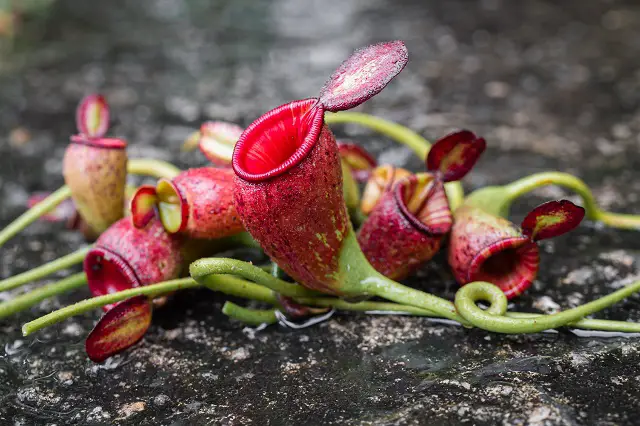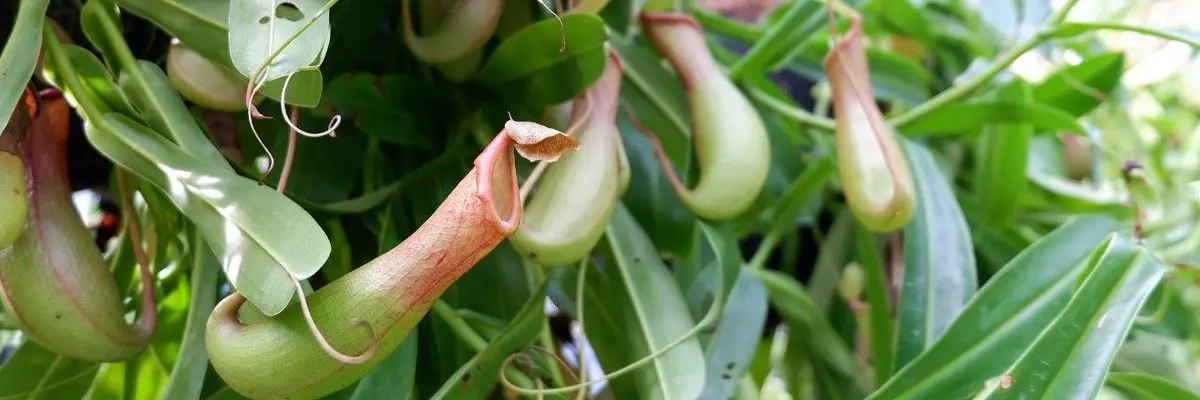Monkey Cups (Nepenthes), also known as pitcher plants, feed on almost any insects, including ants, gnats, fruit flies, houseflies, and rolly pollies. Fertilizer pellets are also useful for pitcher plants. An average Pitcher plant can survive with just one bug every month.
An extensive list of possible foods for Monkey Cups follows, including some insects and other artificial foods:
| Gnats | Moth | Mosquitos |
| Flies | Caterpillars | Butterfly |
| Cricket | Beetles | Spiders |
| Ladybugs | Slug | Fish food |
| Fertilizer pellets | Bloodworms | Grasshoppers |
| Worms | Moth | Rollie pollies |
| Yellow Jackets | Mealworms | Cockroaches |
| Ants | Bees | Fruit flies |
Mealworms, crickets, and bloodworms, which are extremely nutritious insects, can be used as a source of protein. These are both available at most pet stores and provide nutritional benefits. Monkey cups can consume live or dead bugs.
It is generally recommended not to feed Monkey Cups (Pitcher Plants) human food. Monkey Cups do not produce digestive enzymes that can break down human food. Human food can rot if left in its pitchers, attracting fungus, bacteria, and other pests.
Monkey Cups should not be fed any of the following items:
| Chicken | Sausage |
| Cheese | Raw meat |
| Hamburger | Fruit |
| Candy | Salami |
| Hotdog | Steak |
How Do Monkey Cups Capture and Eat Insects
Flying, crawling, and foraging insects, such as Gnats, are attracted to pitchers formed by cupped leaves, usually by visual cues such as the color pigment of the pitchers and nectar it produces. When the pitcher’s rim is wet from water mist or from the plant’s nectar, it becomes slippery, causing the insect to tumble down into the pitcher’s funnel. Furthermore, the waxy scales and aldehyde crystals make it difficult for insects to climb out of pitchers of the Monkey Cup.
In pitcher traps, small droplets of the liquid form called phytotelmata. These droplets suffocate the insects, whose bodies are slowly dissolved. Moreover, some pitcher plants have parasitic insect larvae living inside of the pitchers that eat the trapped prey and whose excrement the plant absorbs as nutrients. The plant may accomplish this by releasing enzymes or by bacterial action.
It doesn’t matter how the insects are digested. They are converted into a liquid consisting of urea, amino acids, phosphates, and several peptides. All of this provides the plant with mineral nutrition that it would have otherwise missed. Plants of the carnivorous family all grow in places where the soil is too acidic and too devoid of minerals to support most plants. In addition to nutrient and mineral intake from their roots, monkey cups (pitcher plants) obtain nutrients from their insect prey.

Nepenthes – the Monkey Cups
Presently, 90 species in Australia, Madagascar, Papua New Guinea, Seychelles, Southeast Asia, and Sri Lanka can be found in tropical habitats.
The Nepenthes plant grows in Southeast Asia and Australia. Similar to the pitcher plant of North America, its pitcher attracts prey by trapping it in water. A very unusual leaf appears as a normal leaf, then forms a tendril at the tip, and finally, the tendril’s tip becomes an amazing pitcher. The tendril is twined around another plant to give it support. Due to its weight, the pitcher swells and droops as it develops. Monkey cups, the pitfall trap, lure its prey in by releasing decaying odors and sometimes bright colors.
At first, the lid on the top of the trap covers the pitcher while it grows. When it matures, it starts inflating with air. Once inflated, it fills with liquid and then opens to reveal the enticing interior. Once the leaf has fully grown, the lid will open, and the trap will be ready.
Rajah pitcher, which is the largest, has the ability to digest mice. Insects are attracted to their nectar. The insect finds that a flaky wax on the interior surface of the pitcher prevents it from attaching itself to its walls. This causes it to fall into the water and struggle to escape. A digestion acid is released by the digestive glands when the motion of the struggle stimulates them. The acid is so powerful that the insect will disappear within a few hours.
It is thought that monkeys once drank rainwater from the pitchers, hence the name “monkey cups.” However, monkeys don’t drink from them, and the pitchers are filled with digestive juices, not rainwater. A typical nepenthes leaf has a small, symmetrical pitcher borne at the end of a tendril that extends from the midrib: the pitchers usually display a waxy coating on the inner wall of the pitcher. Some of these plants can be found as climbers, accessing the canopy of their habitats using the tendrils mentioned earlier. In contrast, others are found on the ground in clearings in forests or as epiphytes on trees.

